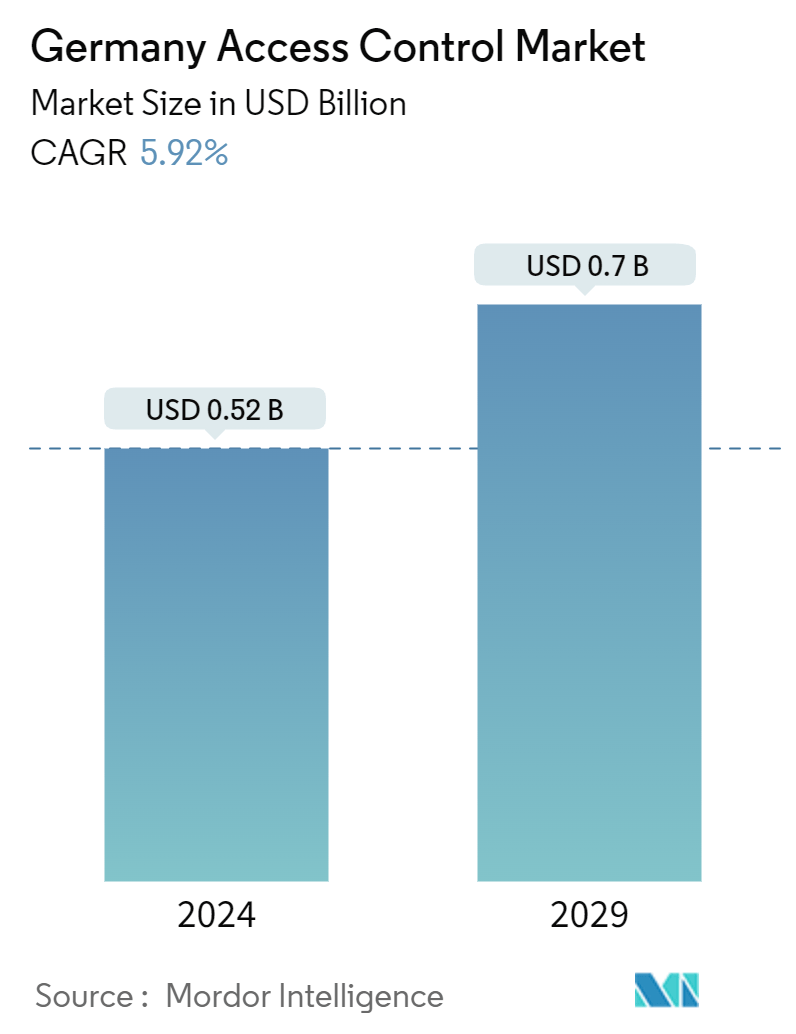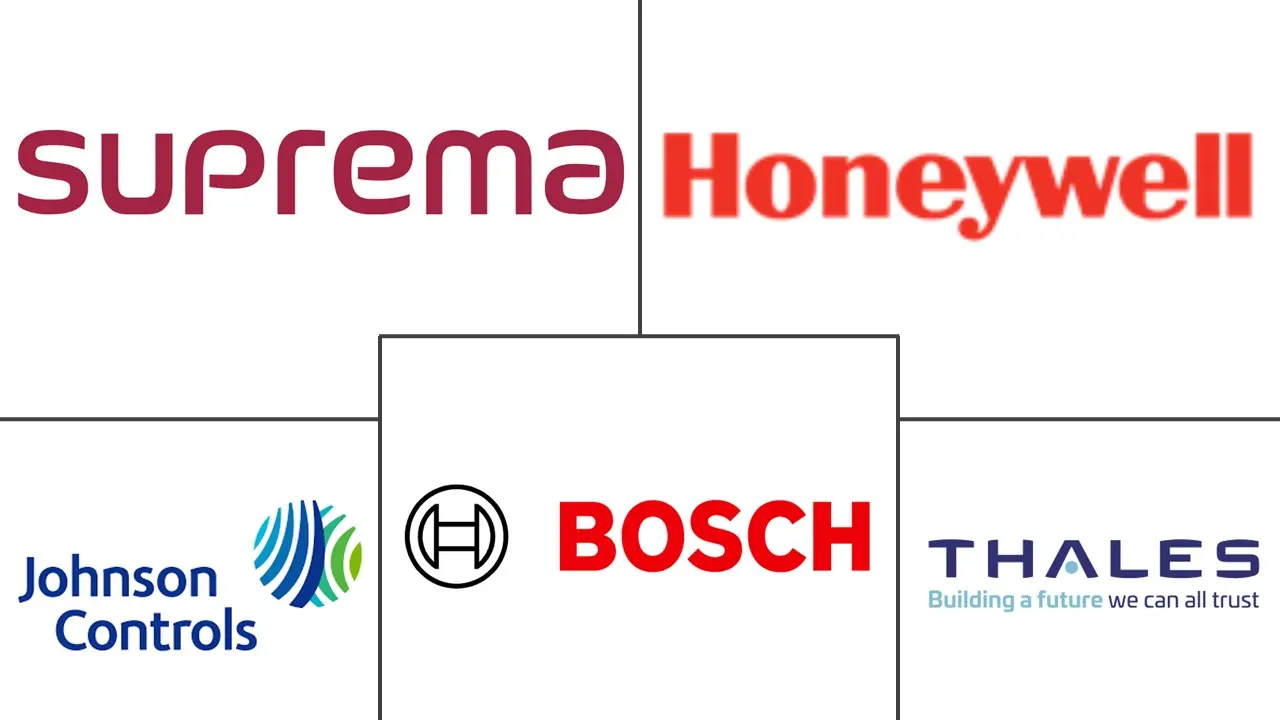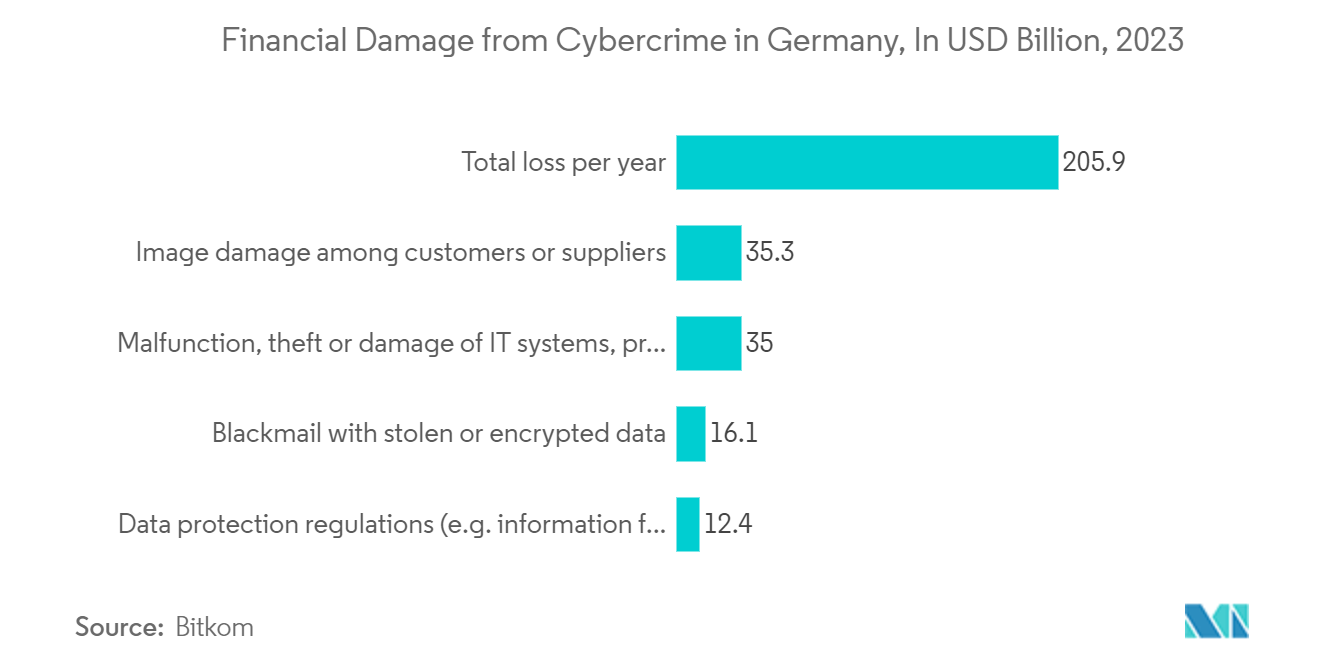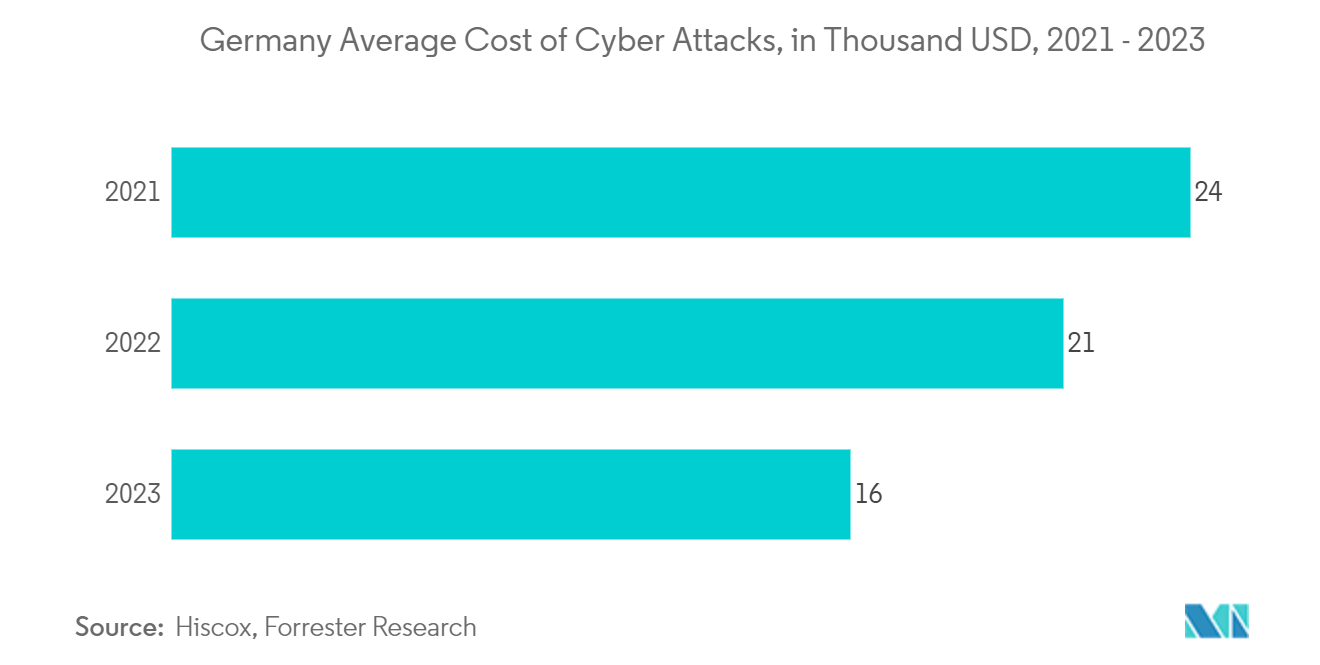Germany Access Control Market Size

| Study Period | 2019 - 2029 |
| Base Year For Estimation | 2023 |
| Forecast Data Period | 2024 - 2029 |
| Market Size (2024) | USD 0.52 Billion |
| Market Size (2029) | USD 0.7 Billion |
| CAGR (2024 - 2029) | 5.92 % |
| Market Concentration | Low |
Major Players
*Disclaimer: Major Players sorted in no particular order |
Germany Access Control Market Analysis
The Germany Access Control Market size is estimated at USD 0.52 billion in 2024, and is expected to reach USD 0.7 billion by 2029, growing at a CAGR of 5.92% during the forecast period (2024-2029).
- Germany, known for its robust economy and technological advancements, hosts a thriving access control market poised for significant growth. As businesses and organizations prioritize security measures, sophisticated access control solutions have surged, driving innovation and competition within the industry.
- The increasing adoption of smart technologies across various commercial, industrial, and residential sectors has propelled the demand for access control solutions in Germany. In 2023, Hamburg topped the smart city index. Integrated with IoT technology, modern access control systems offer seamless connectivity and more management capabilities, enhancing efficiency and convenience for end users.
- At the heart of Germany's access control market are physical access control systems, which include various hardware such as biometric scanners, card readers, electronic locks, and turnstiles. Biometric systems, which utilize unique biological traits like fingerprints, facial features, and iris patterns, offer high levels of security and are becoming increasingly prevalent. Card readers and keypads, which use RFID technology or require PIN entry, remain popular due to their reliability and ease of integration into existing security frameworks.
- The increasing frequency of cyber-attacks, physical security threats, and incidents of terrorism is concerning. Cybercrime in Germany is on the rise and is reported to be costing an estimated EUR 148 billion (USD 159.29 billion) in damage to the economy. Data revealed by the German authorities showed a 28% increase in cyberattacks by foreign organizations in 2023, particularly from Russia and China.
- Regulatory requirements also play a crucial role in the market’s expansion. Germany has stringent data protection and privacy laws, such as the General Data Protection Regulation (GFPR), which mandate robust security measures to protect personal and organizational data. Compliance with these regulations necessitates the implementation of advanced access control systems that can ensure data security and privacy, thus shaping the market.
- The recent rising threat of terrorism in Germany necessitates enhanced security measures to protect public spaces, critical infrastructure, and private properties, leading to a surge in demand for sophisticated security systems. The rise in recent attacks across Europe, combined with geopolitical instability, has led Germany to raise the national security system.
- Challenges persist in the real estate sector, notably highlighted by a recent downturn in Germany's market. Germany finds itself at the forefront of this struggle, grappling with its most severe real estate crisis in years. Compounding these issues are challenges in refinancing and a drop in office vacancies, a trend fueled by the sustained prevalence of remote work. Combine Consulting's data revealed that German office occupancy plummeted to 40% in July 2023, down from the pre-pandemic level of 61%. Such factors are expected to limit the market’s growth.
Germany Access Control Market Trends
Commercial Segment Holds Highest Market Share
- As businesses across various industries seek to safeguard their premises, assets, and sensitive information, the demand for sophisticated access control systems has surged. One key factor driving the growth is the rising adoption of cloud-based solutions. Cloud-based access control systems offer numerous advantages, including scalability, remote management capabilities, and ease of integration with existing IT infrastructure. The convenience provided by cloud-based solutions allows them to manage access permissions, monitor security events, and generate reports from anywhere with an internet connection.
- Another significant trend in the German commercial access control systems market is the convergence of access control systems with other building management systems (BMS). The integration with systems such as video surveillance, intruder detection, and visitor management enables businesses to create comprehensive security ecosystems.
- By centralizing control and monitoring functions, integrated access control systems enhance operational efficiency and enable proactive security management. In December 2023, The Rudolf Weber-Arena in Oberhausen, Germany, underwent a comprehensive safety and security upgrade by Bosch Building Technologies.
- Data security and privacy compliance stand out as a key restraint, significantly influencing the market landscape. A striking 80% of targeted firms fell victim to data breaches, espionage, or sabotage, as reported by Bitkom, the German digital industry association. Notably, data from German authorities highlighted a 28% surge in cyberattacks by foreign entities in 2023, with Russia and China at the forefront.
- Such alarming statistics fuel concerns, potentially hindering the adoption of access control systems reliant on personal data. Against this backdrop, businesses, under the watchful eye of regulations like the General Data Protection Regulation (GDPR), are increasingly gravitating toward solutions that guarantee robust data protection and handling.
- As the commercial access control systems market in Germany continues to evolve, innovation remains a driving force behind the development of next-generation solutions. AI, machine learning, and predictive analytics are increasingly being integrated into access control systems to enhance threat detection, anomaly detection, and risk assessment capabilities. These advanced technologies empower businesses to proactively mitigate security risks and respond swiftly to security incidents.

Biometric to Witness Significant Growth Rate
- Biometrics readers have become a cornerstone, offering advanced security solutions that blend convenience with high levels of protection. These devices utilize unique biological traits such as fingerprints, iris patterns, or facial features to verify a person's identity, granting or denying access to restricted areas accordingly. As Germany emphasizes privacy and data protection, biometrics readers must comply with strict regulations to ensure the security and integrity of personal information.
- One of the primary advantages of biometric readers in the German access control market is their heightened security compared to traditional methods such as keycards or PIN codes. It offers unparalleled convenience and efficiency in managing access control systems. This streamlined process enhances user experience and improves overall operational efficiency for organizations across various industries.
- Airports in Germany are utilizing biometrics for efficient operations. For example, in October 2023, Lufthansa introduced biometric access at Munich Airport's Business Schengen lounge, allowing business class travelers and frequent flyers to enter without showing their boarding passes. Using Gate 28, passengers can utilize a facial recognition system provided by Star Alliance in partnership with NEC and SITA. To utilize this system, passengers must register on the Miles & More app 24 hours prior to departure, providing their passport information.
- Around the same time, Munich Airport launched a pilot project for autonomous passenger boarding bridges in Terminal 2. Dabico Airport Solutions Germany GmbH, which acquired FMT, signed a letter of intent with the airport during the inter-airport Europe 2023 exhibition, aiming to explore the requirements for the autonomous operation of passenger boarding bridges. This showcases the increasing use and reliance on biometrics to fast-track operations and tighten security measures.
- Biometric readers are also being enhanced by integrating them with artificial intelligence (AI) and machine learning. These integrations improve accuracy and allow the systems to adapt to changing conditions. The biometric reader segment in the German market is growing rapidly due to the need for better security, technological advancements, the demand for contactless solutions, and supportive regulation. As organizations continue to focus on security and efficiency, the use of biometric readers is expected to keep increasing, making them a key part of modern access control systems in Germany.

Germany Access Control Industry Overview
The German access control market is highly fragmented, as it is characterized by the presence of numerous key players and continuous technological advancements. Companies in this market consistently innovate to meet the evolving security needs of various sectors, including commercial, residential, and government. Firms invest heavily in R&D to create more sophisticated and user-friendly access control systems. The market features various products and solutions tailored to different security needs.
- April 2024: Schneider Electric and IPConfigure have joined forces to integrate advanced video surveillance solutions into Schneider Electric's EcoStruxure Buildings platform. They offer an unparalleled security ecosystem by combining Schneider Electric's Access Expert and Security Expert products with IPConfigure's Orchid video management system. Orchid, known for its simplicity and scalability, will seamlessly integrate with EcoStruxure's Security Expert and Access Expert platforms, providing users with comprehensive security features accessible from any device.
- December 2023: Nedap launched Access AtWork, a SaaS access control system designed for convenience and security. This modern software replaces outdated on-premises systems, offering better insights with minimal effort and investment. Nedap's Access AtWork complements their AEOS solution, catering to small and medium-sized enterprises. It features a smart authorization model, allowing administrators to manage access across sites easily.
Germany Access Control Market Leaders
-
GRAEF Gruppe
-
Suprema Inc.
-
Thales Group
-
Bosch Security Systems
-
Honeywell International Inc.
*Disclaimer: Major Players sorted in no particular order

Germany Access Control Market News
- March 2024: Essence Security, part of the Essence Group, partnered with GRAEF Gruppe, Germany's leading security service provider, to distribute and implement Essence's MyShield standalone connected smoke-generating intruder intervention solution across Germany. GRAEF Gruppe will distribute MyShield through its extensive network of security installers, incorporating it into major projects to meet rising demands for enhanced protection.
- December 2023: The Rudolf Weber-Arena in Oberhausen, Germany, underwent a comprehensive safety and security upgrade by Bosch Building Technologies. A networked video security and access control solution was installed, along with a visitor management system for efficient backstage entrance management. This system allows staff to register visitors via tablet and issue access badges, ensuring precise tracking of individuals on-site.
Germany Access Control Market Report - Table of Contents
1. INTRODUCTION
1.1 Study Assumptions and Market Definition
1.2 Scope of the Study
2. RESEARCH METHODOLOGY
3. EXECUTIVE SUMMARY
4. MARKET INSIGHTS
4.1 Market Overview
4.2 Industry Attractiveness - Porter's Five Forces Analysis
4.2.1 Bargaining Power of Suppliers
4.2.2 Bargaining Power of Consumers
4.2.3 Threat of New Entrants
4.2.4 Threat of Substitute Products
4.2.5 Intensity of Competitive Rivalry
4.3 Industry Value Chain Analysis
4.4 Impact of COVID-19 Aftereffects and Other Macroeconomic Factors on the Market
5. MARKET DYNAMICS
5.1 Market Drivers
5.1.1 Growing Adoption of Access Control Systems owing to Rising Crime Rates and Threats
5.1.2 Technological Advancements in the Access Control Market
5.2 Market Challenges
5.2.1 Operational and ROI Concerns
6. MARKET SEGMENTATION
6.1 By Type
6.1.1 Card Reader and Access Control Devices
6.1.1.1 Card-based
6.1.1.2 Proximity
6.1.1.3 Smart Card (Contact and Contactless)
6.1.2 Biometric Readers
6.1.3 Electronic Locks
6.1.4 Software
6.1.5 Other Types
6.2 By End User Vertical
6.2.1 Commercial
6.2.2 Residential
6.2.3 Government
6.2.4 Industrial
6.2.5 Transport and Logistics
6.2.6 Healthcare
6.2.7 Military and Defense
6.2.8 Other End User Verticals
7. COMPETITIVE LANDSCAPE
7.1 Company Profiles*
7.1.1 Suprema Inc.
7.1.2 Thales Group
7.1.3 Bosch Security Systems
7.1.4 Honeywell International Inc.
7.1.5 Johnson Controls International PLC
7.1.6 Allegion PLC
7.1.7 Schneider Electric SE
7.1.8 Brivo Inc.
7.1.9 Nedap
7.1.10 GRAEF Gruppe
7.1.11 IDEMIA
8. INVESTMENT ANALYSIS
9. FUTURE OF THE MARKET
Germany Access Control Industry Segmentation
The access control market refers to an industry segment that deals with systems and solutions designed to regulate who can view or use resources in a computing environment. This includes technologies and services that manage permissions, authentications, and authorization to ensure security and compliance in various settings, such as physical spaces (buildings, offices) and digital environments (networks, software applications)
The German access control market is segmented by type (card reader & access control devices [card-based, proximity, and smart card], biometric readers, electronic locks, software, and other types) and end-user vertical (commercial, residential, government, industrial, transport & logistics, healthcare, military & defense, and other end-user verticals). The market sizes and forecasts are provided in terms of value (USD) for all the segments.
| By Type | |||||
| |||||
| Biometric Readers | |||||
| Electronic Locks | |||||
| Software | |||||
| Other Types |
| By End User Vertical | |
| Commercial | |
| Residential | |
| Government | |
| Industrial | |
| Transport and Logistics | |
| Healthcare | |
| Military and Defense | |
| Other End User Verticals |
Germany Access Control Market Research FAQs
How big is the Germany Access Control Market?
The Germany Access Control Market size is expected to reach USD 0.52 billion in 2024 and grow at a CAGR of 5.92% to reach USD 0.7 billion by 2029.
What is the current Germany Access Control Market size?
In 2024, the Germany Access Control Market size is expected to reach USD 0.52 billion.
Who are the key players in Germany Access Control Market?
GRAEF Gruppe, Suprema Inc., Thales Group, Bosch Security Systems and Honeywell International Inc. are the major companies operating in the Germany Access Control Market.
What years does this Germany Access Control Market cover, and what was the market size in 2023?
In 2023, the Germany Access Control Market size was estimated at USD 0.49 billion. The report covers the Germany Access Control Market historical market size for years: 2019, 2020, 2021, 2022 and 2023. The report also forecasts the Germany Access Control Market size for years: 2024, 2025, 2026, 2027, 2028 and 2029.
Germany Access Control Industry Report
Statistics for the 2024 Germany Access Control market share, size and revenue growth rate, created by Mordor Intelligence™ Industry Reports. Germany Access Control analysis includes a market forecast outlook for 2024 to 2029 and historical overview. Get a sample of this industry analysis as a free report PDF download.



